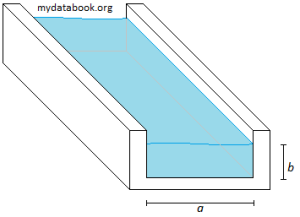Spotted an error on this page? Please help improve the quality of this site! E-mail: webmaster@mydatabook.org
Pages
- Home
- Fluid Mechanics
- Mathematics
- Solid Mechanics
- Thermodynamics
Reynold’s Number
The Reynold’s number is a dimensionless number that characterises the flow of a fluid and is represented by:
(1) ![]()
Where Re = Reynold’s number, ![]() = density, u = fluid velocity,
= density, u = fluid velocity, ![]() = characteristic length or hydraulic diameter,
= characteristic length or hydraulic diameter, ![]() = dynamic viscosity. It can be alternatively written in terms of the kinematic visocity:
= dynamic viscosity. It can be alternatively written in terms of the kinematic visocity:
(2) ![]()
Where ![]() = kinematic visocity and is equivalent to
= kinematic visocity and is equivalent to ![]() .
.
The Reynold’s Number characterises the flow as laminar when Re < 2000, as transient when 2000 < Re < 4000 and as turbulent when Re > 4000.
Characteristic Length / Hydraulic Diameter
The characteristic length, also known as the hydraulic diameter, is the ratio of cross-sectional area to the ‘wetted’ perimeter of the tube or channel the flow is moving through. It is defined as:
(3) ![]()
Where A = cross-sectional area and P = perimeter of the channel or tube in contact with the fluid.
For example, the characteristic length for a fully filled tube with internal diameter, D, is:
(4) ![]()
For a fully filled square channel with side length, L, the characteristic length is:
(5) ![]()
A partially filled rectangular open channel with width, a, and height, b, is shown below:

Here, only 3 surfaces are in contact with the fluid and are ‘wetted’. The ‘wetted’ perimeter is therefore only (a + 2b). As such the the characteristic length is:
(6) ![]()
Reynold’s Number Calculator from Dynamic Viscosity
Reynold’s Number Calculator from Kinematic Viscosity
By continuing to use the site, you agree to the use of cookies. more information
The cookie settings on this website are set to "allow cookies" to give you the best browsing experience possible. If you continue to use this website without changing your cookie settings or you click "Accept" below then you are consenting to this.